BSBADM502 Manage Meetings: Solutions, Agenda & Meeting Process
VerifiedAdded on 2024/05/20
|32
|4811
|399
Homework Assignment
AI Summary
This document provides solutions to activities related to BSBADM502 Manage Meetings. It covers various aspects of meeting management, including agenda development, participant notification, meeting arrangements, and dispatching meeting papers. The solutions address the differences between formal and informal groups, the stages of team formation (forming, storming, norming, performing), and the leadership skills required for chairing meetings. Furthermore, it explores effective agenda creation, techniques for stimulating discussion, conflict resolution strategies, and the roles of both the chair and the minute taker. The document also details the process of conducting formal annual meetings, including preparation, meeting procedures, participant engagement, and the creation, distribution, and storage of meeting minutes. This resource helps students understand and apply key concepts in meeting management.
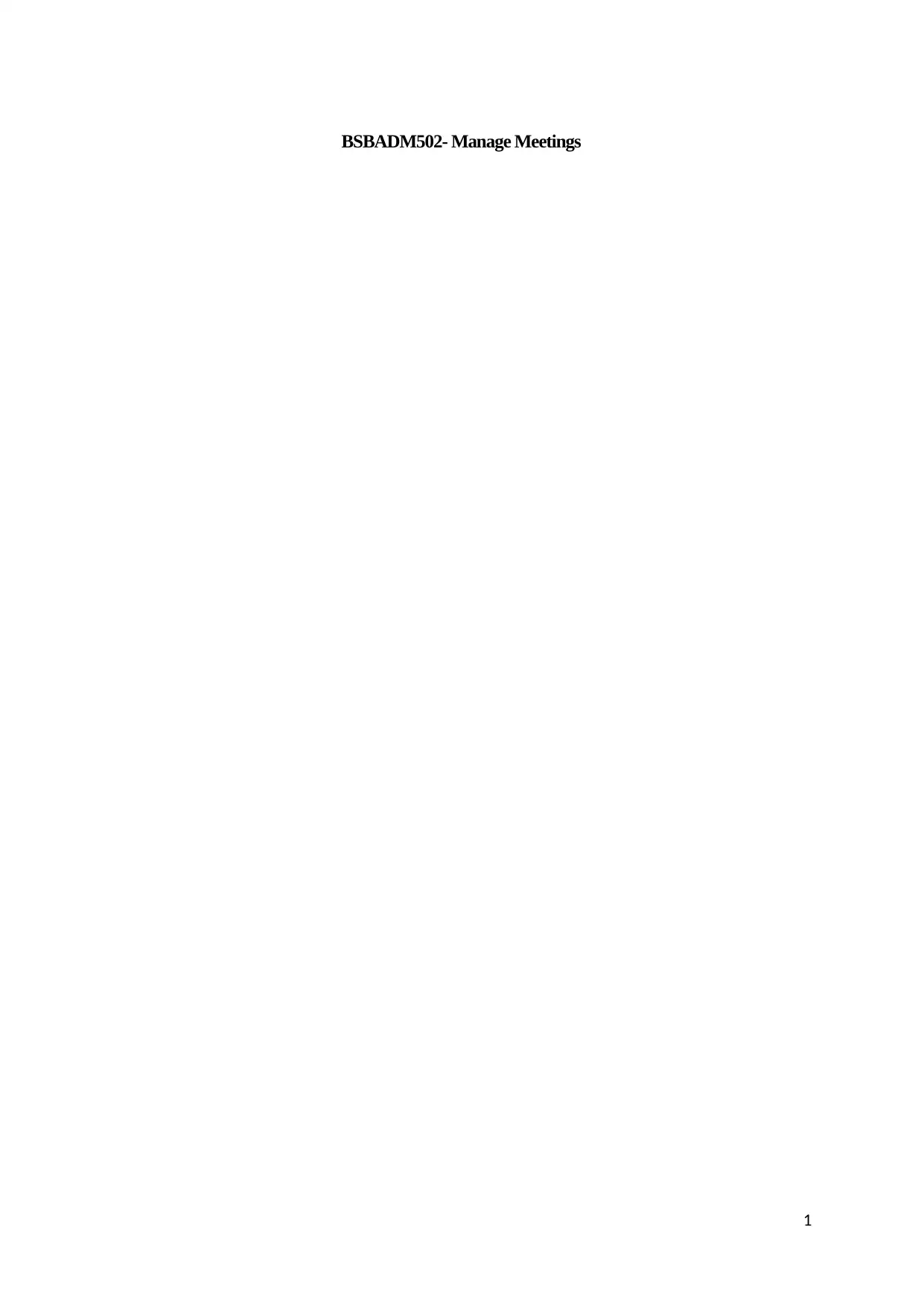
BSBADM502- Manage Meetings
1
1
Paraphrase This Document
Need a fresh take? Get an instant paraphrase of this document with our AI Paraphraser
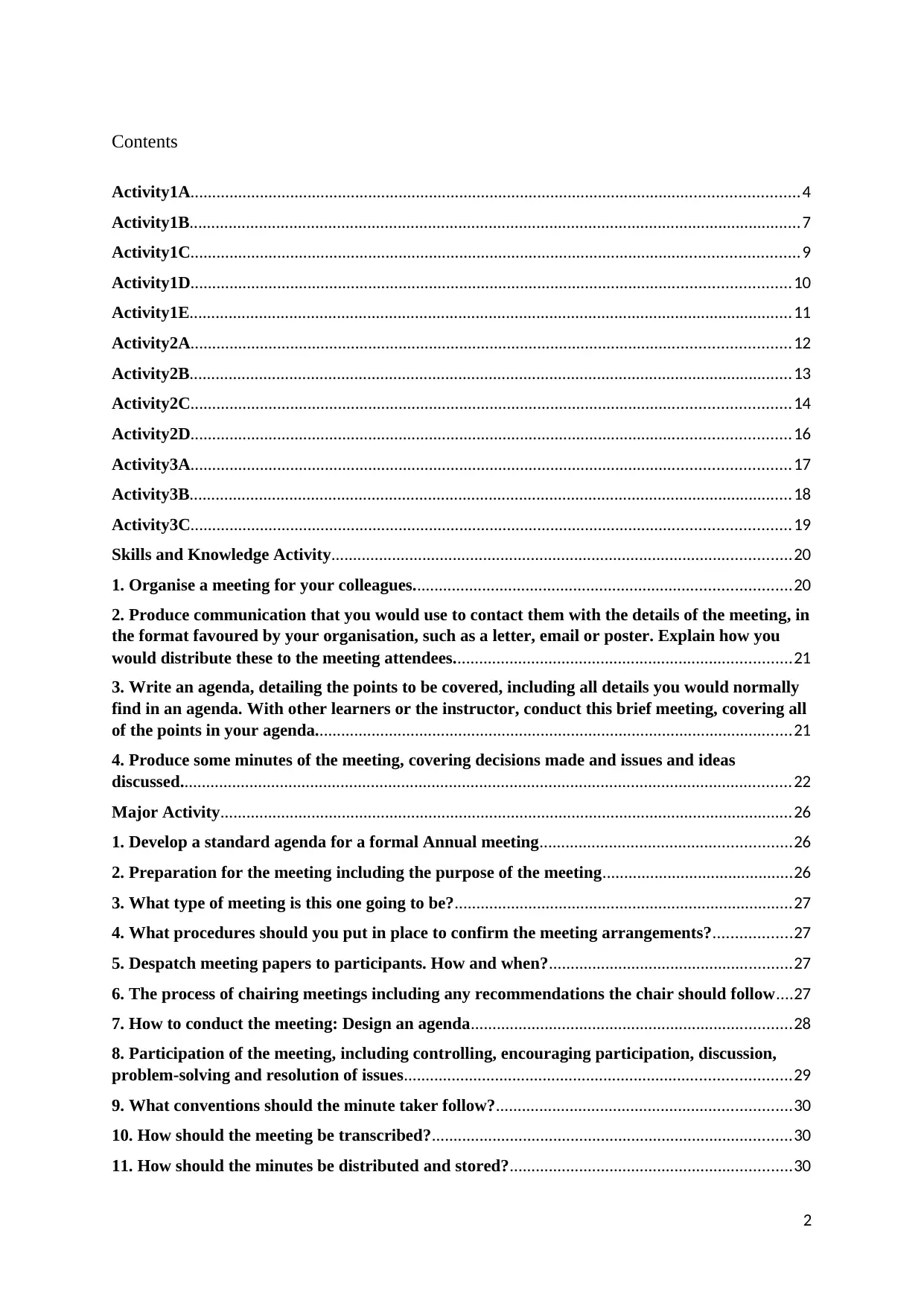
Contents
Activity1A............................................................................................................................................4
Activity1B.............................................................................................................................................7
Activity1C............................................................................................................................................9
Activity1D..........................................................................................................................................10
Activity1E...........................................................................................................................................11
Activity2A..........................................................................................................................................12
Activity2B...........................................................................................................................................13
Activity2C..........................................................................................................................................14
Activity2D..........................................................................................................................................16
Activity3A..........................................................................................................................................17
Activity3B...........................................................................................................................................18
Activity3C..........................................................................................................................................19
Skills and Knowledge Activity..........................................................................................................20
1. Organise a meeting for your colleagues.......................................................................................20
2. Produce communication that you would use to contact them with the details of the meeting, in
the format favoured by your organisation, such as a letter, email or poster. Explain how you
would distribute these to the meeting attendees..............................................................................21
3. Write an agenda, detailing the points to be covered, including all details you would normally
find in an agenda. With other learners or the instructor, conduct this brief meeting, covering all
of the points in your agenda..............................................................................................................21
4. Produce some minutes of the meeting, covering decisions made and issues and ideas
discussed.............................................................................................................................................22
Major Activity....................................................................................................................................26
1. Develop a standard agenda for a formal Annual meeting..........................................................26
2. Preparation for the meeting including the purpose of the meeting............................................26
3. What type of meeting is this one going to be?..............................................................................27
4. What procedures should you put in place to confirm the meeting arrangements?..................27
5. Despatch meeting papers to participants. How and when?........................................................27
6. The process of chairing meetings including any recommendations the chair should follow....27
7. How to conduct the meeting: Design an agenda..........................................................................28
8. Participation of the meeting, including controlling, encouraging participation, discussion,
problem-solving and resolution of issues.........................................................................................29
9. What conventions should the minute taker follow?....................................................................30
10. How should the meeting be transcribed?...................................................................................30
11. How should the minutes be distributed and stored?.................................................................30
2
Activity1A............................................................................................................................................4
Activity1B.............................................................................................................................................7
Activity1C............................................................................................................................................9
Activity1D..........................................................................................................................................10
Activity1E...........................................................................................................................................11
Activity2A..........................................................................................................................................12
Activity2B...........................................................................................................................................13
Activity2C..........................................................................................................................................14
Activity2D..........................................................................................................................................16
Activity3A..........................................................................................................................................17
Activity3B...........................................................................................................................................18
Activity3C..........................................................................................................................................19
Skills and Knowledge Activity..........................................................................................................20
1. Organise a meeting for your colleagues.......................................................................................20
2. Produce communication that you would use to contact them with the details of the meeting, in
the format favoured by your organisation, such as a letter, email or poster. Explain how you
would distribute these to the meeting attendees..............................................................................21
3. Write an agenda, detailing the points to be covered, including all details you would normally
find in an agenda. With other learners or the instructor, conduct this brief meeting, covering all
of the points in your agenda..............................................................................................................21
4. Produce some minutes of the meeting, covering decisions made and issues and ideas
discussed.............................................................................................................................................22
Major Activity....................................................................................................................................26
1. Develop a standard agenda for a formal Annual meeting..........................................................26
2. Preparation for the meeting including the purpose of the meeting............................................26
3. What type of meeting is this one going to be?..............................................................................27
4. What procedures should you put in place to confirm the meeting arrangements?..................27
5. Despatch meeting papers to participants. How and when?........................................................27
6. The process of chairing meetings including any recommendations the chair should follow....27
7. How to conduct the meeting: Design an agenda..........................................................................28
8. Participation of the meeting, including controlling, encouraging participation, discussion,
problem-solving and resolution of issues.........................................................................................29
9. What conventions should the minute taker follow?....................................................................30
10. How should the meeting be transcribed?...................................................................................30
11. How should the minutes be distributed and stored?.................................................................30
2
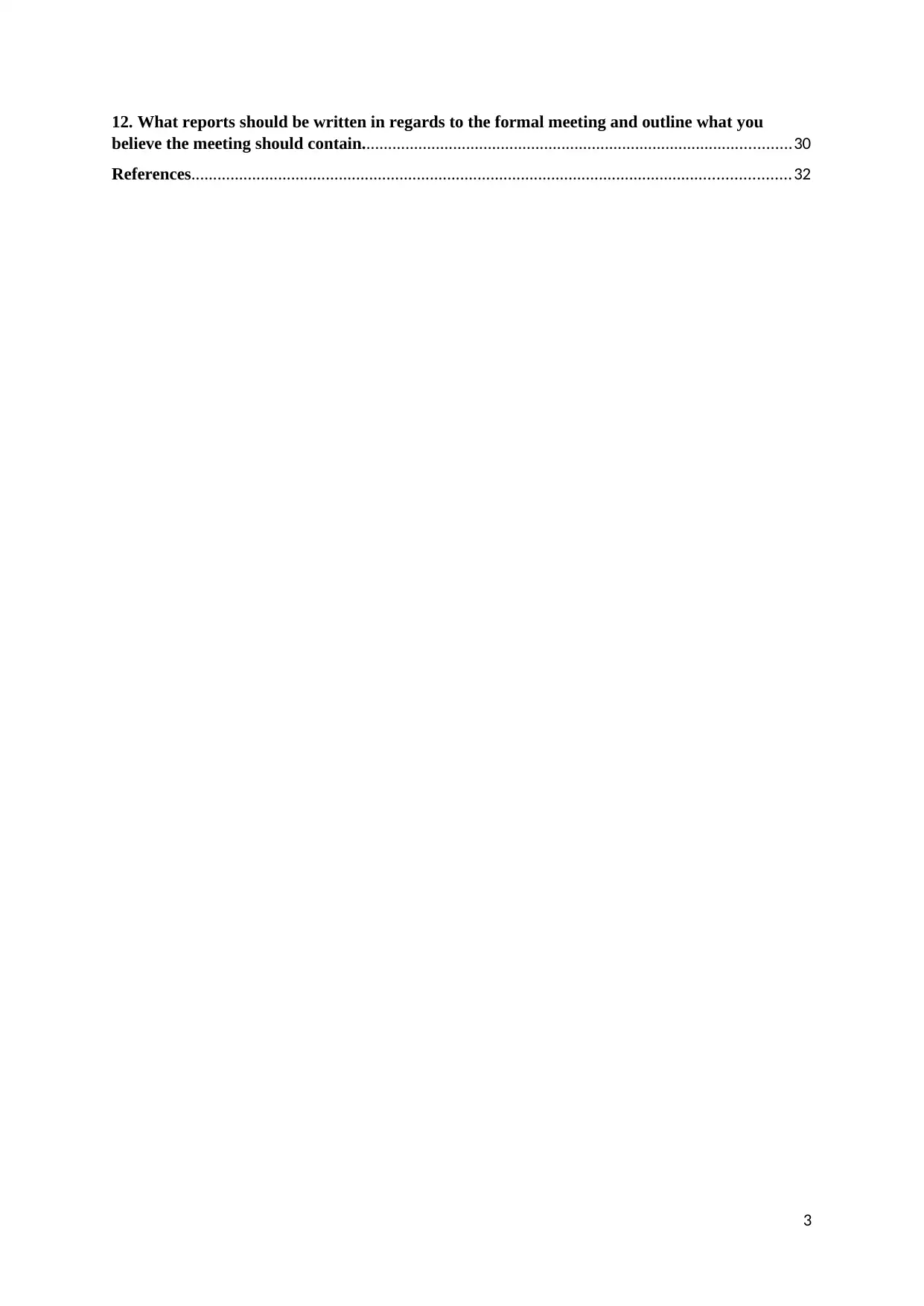
12. What reports should be written in regards to the formal meeting and outline what you
believe the meeting should contain...................................................................................................30
References..........................................................................................................................................32
3
believe the meeting should contain...................................................................................................30
References..........................................................................................................................................32
3
⊘ This is a preview!⊘
Do you want full access?
Subscribe today to unlock all pages.

Trusted by 1+ million students worldwide
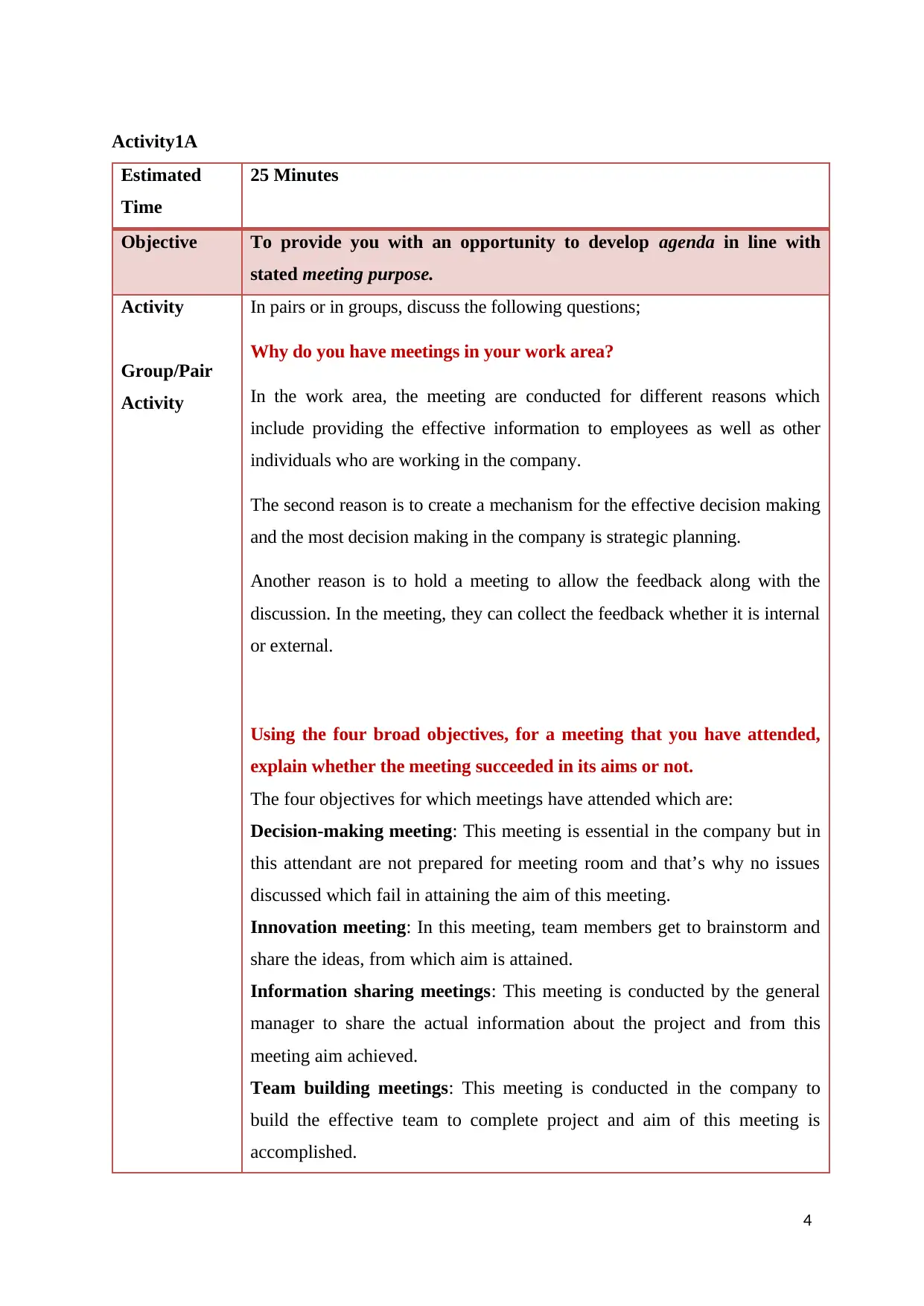
Activity1A
Estimated
Time
25 Minutes
Objective To provide you with an opportunity to develop agenda in line with
stated meeting purpose.
Activity
Group/Pair
Activity
In pairs or in groups, discuss the following questions;
Why do you have meetings in your work area?
In the work area, the meeting are conducted for different reasons which
include providing the effective information to employees as well as other
individuals who are working in the company.
The second reason is to create a mechanism for the effective decision making
and the most decision making in the company is strategic planning.
Another reason is to hold a meeting to allow the feedback along with the
discussion. In the meeting, they can collect the feedback whether it is internal
or external.
Using the four broad objectives, for a meeting that you have attended,
explain whether the meeting succeeded in its aims or not.
The four objectives for which meetings have attended which are:
Decision-making meeting: This meeting is essential in the company but in
this attendant are not prepared for meeting room and that’s why no issues
discussed which fail in attaining the aim of this meeting.
Innovation meeting: In this meeting, team members get to brainstorm and
share the ideas, from which aim is attained.
Information sharing meetings: This meeting is conducted by the general
manager to share the actual information about the project and from this
meeting aim achieved.
Team building meetings: This meeting is conducted in the company to
build the effective team to complete project and aim of this meeting is
accomplished.
4
Estimated
Time
25 Minutes
Objective To provide you with an opportunity to develop agenda in line with
stated meeting purpose.
Activity
Group/Pair
Activity
In pairs or in groups, discuss the following questions;
Why do you have meetings in your work area?
In the work area, the meeting are conducted for different reasons which
include providing the effective information to employees as well as other
individuals who are working in the company.
The second reason is to create a mechanism for the effective decision making
and the most decision making in the company is strategic planning.
Another reason is to hold a meeting to allow the feedback along with the
discussion. In the meeting, they can collect the feedback whether it is internal
or external.
Using the four broad objectives, for a meeting that you have attended,
explain whether the meeting succeeded in its aims or not.
The four objectives for which meetings have attended which are:
Decision-making meeting: This meeting is essential in the company but in
this attendant are not prepared for meeting room and that’s why no issues
discussed which fail in attaining the aim of this meeting.
Innovation meeting: In this meeting, team members get to brainstorm and
share the ideas, from which aim is attained.
Information sharing meetings: This meeting is conducted by the general
manager to share the actual information about the project and from this
meeting aim achieved.
Team building meetings: This meeting is conducted in the company to
build the effective team to complete project and aim of this meeting is
accomplished.
4
Paraphrase This Document
Need a fresh take? Get an instant paraphrase of this document with our AI Paraphraser
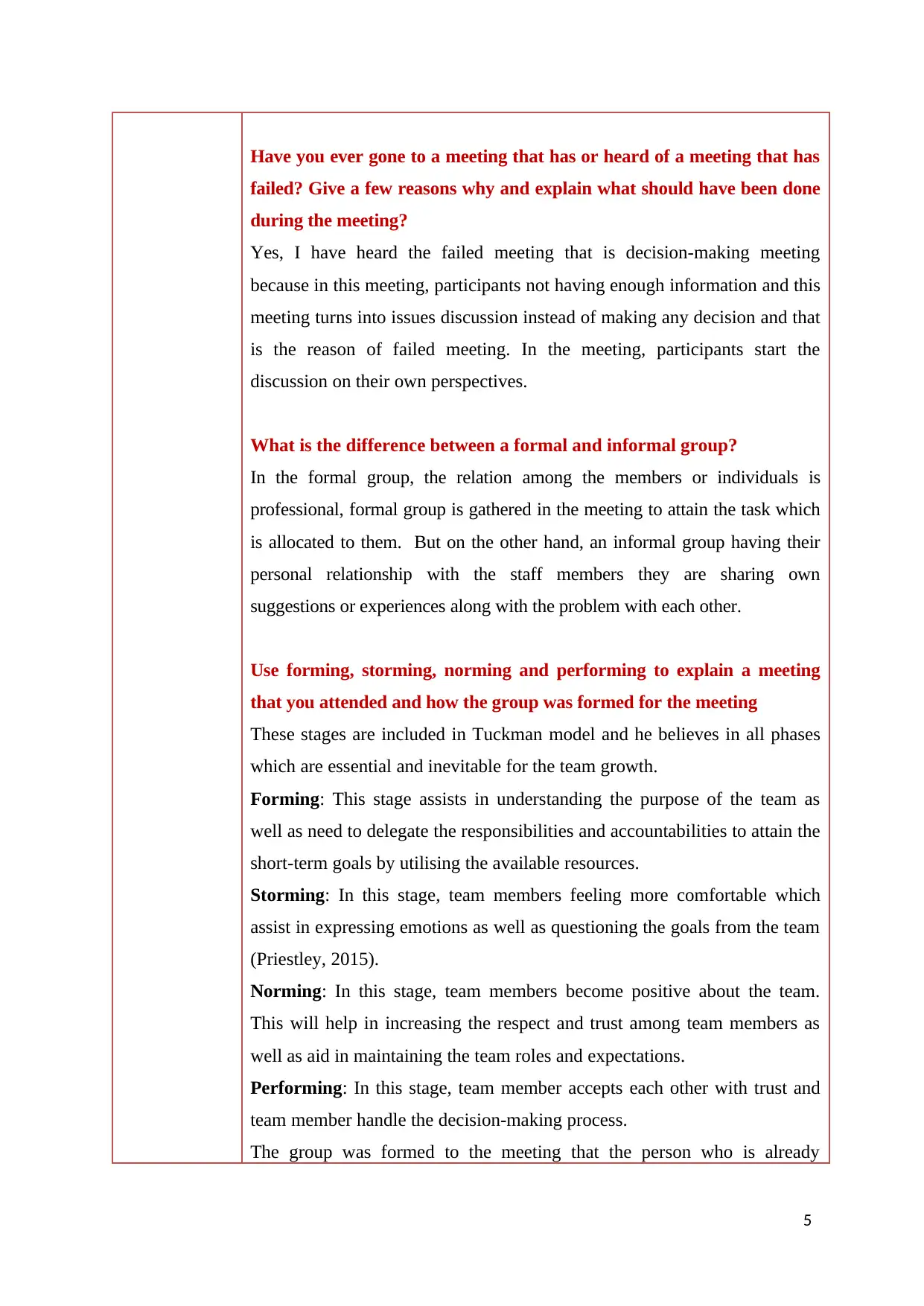
Have you ever gone to a meeting that has or heard of a meeting that has
failed? Give a few reasons why and explain what should have been done
during the meeting?
Yes, I have heard the failed meeting that is decision-making meeting
because in this meeting, participants not having enough information and this
meeting turns into issues discussion instead of making any decision and that
is the reason of failed meeting. In the meeting, participants start the
discussion on their own perspectives.
What is the difference between a formal and informal group?
In the formal group, the relation among the members or individuals is
professional, formal group is gathered in the meeting to attain the task which
is allocated to them. But on the other hand, an informal group having their
personal relationship with the staff members they are sharing own
suggestions or experiences along with the problem with each other.
Use forming, storming, norming and performing to explain a meeting
that you attended and how the group was formed for the meeting
These stages are included in Tuckman model and he believes in all phases
which are essential and inevitable for the team growth.
Forming: This stage assists in understanding the purpose of the team as
well as need to delegate the responsibilities and accountabilities to attain the
short-term goals by utilising the available resources.
Storming: In this stage, team members feeling more comfortable which
assist in expressing emotions as well as questioning the goals from the team
(Priestley, 2015).
Norming: In this stage, team members become positive about the team.
This will help in increasing the respect and trust among team members as
well as aid in maintaining the team roles and expectations.
Performing: In this stage, team member accepts each other with trust and
team member handle the decision-making process.
The group was formed to the meeting that the person who is already
5
failed? Give a few reasons why and explain what should have been done
during the meeting?
Yes, I have heard the failed meeting that is decision-making meeting
because in this meeting, participants not having enough information and this
meeting turns into issues discussion instead of making any decision and that
is the reason of failed meeting. In the meeting, participants start the
discussion on their own perspectives.
What is the difference between a formal and informal group?
In the formal group, the relation among the members or individuals is
professional, formal group is gathered in the meeting to attain the task which
is allocated to them. But on the other hand, an informal group having their
personal relationship with the staff members they are sharing own
suggestions or experiences along with the problem with each other.
Use forming, storming, norming and performing to explain a meeting
that you attended and how the group was formed for the meeting
These stages are included in Tuckman model and he believes in all phases
which are essential and inevitable for the team growth.
Forming: This stage assists in understanding the purpose of the team as
well as need to delegate the responsibilities and accountabilities to attain the
short-term goals by utilising the available resources.
Storming: In this stage, team members feeling more comfortable which
assist in expressing emotions as well as questioning the goals from the team
(Priestley, 2015).
Norming: In this stage, team members become positive about the team.
This will help in increasing the respect and trust among team members as
well as aid in maintaining the team roles and expectations.
Performing: In this stage, team member accepts each other with trust and
team member handle the decision-making process.
The group was formed to the meeting that the person who is already
5
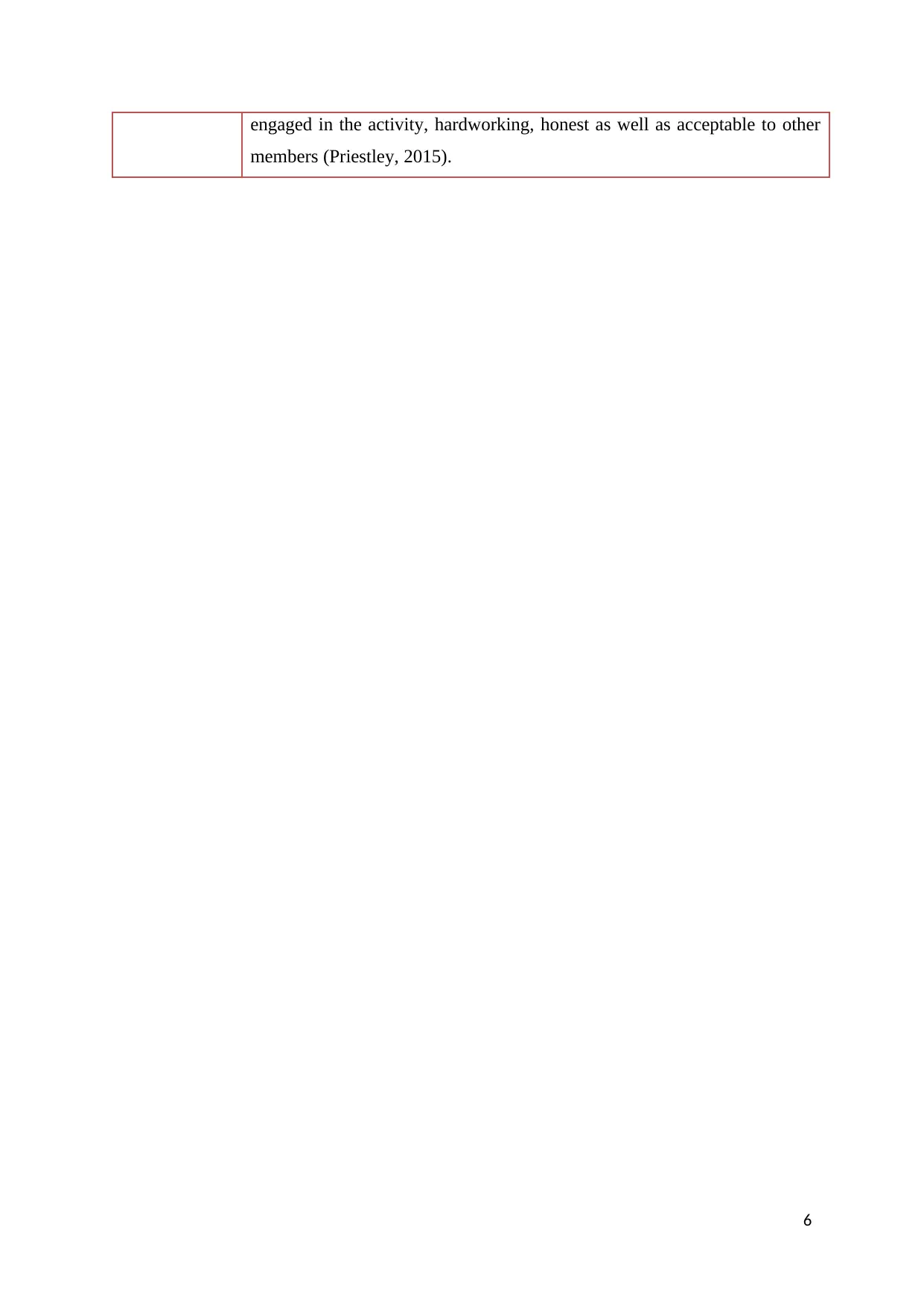
engaged in the activity, hardworking, honest as well as acceptable to other
members (Priestley, 2015).
6
members (Priestley, 2015).
6
⊘ This is a preview!⊘
Do you want full access?
Subscribe today to unlock all pages.

Trusted by 1+ million students worldwide
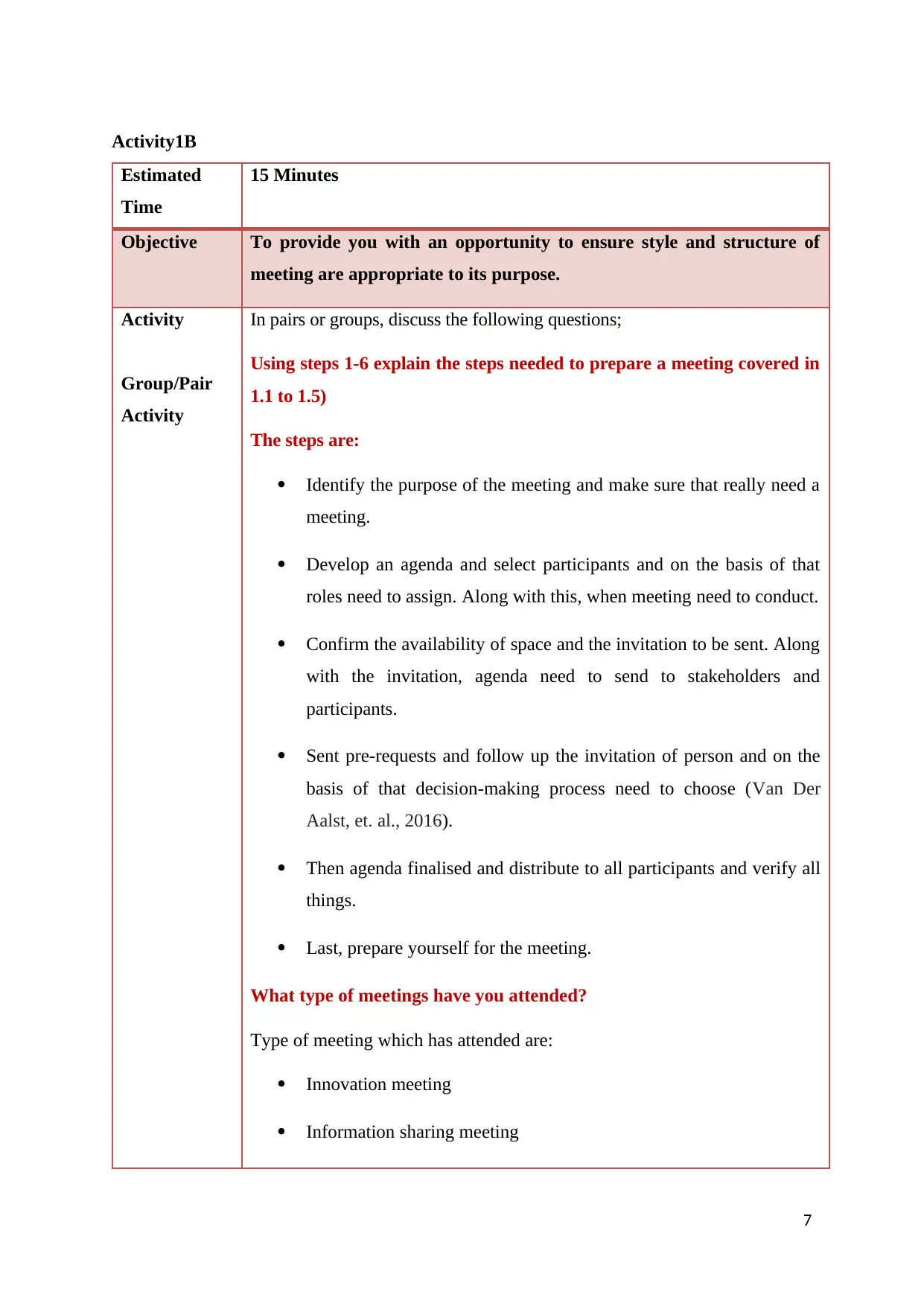
Activity1B
Estimated
Time
15 Minutes
Objective To provide you with an opportunity to ensure style and structure of
meeting are appropriate to its purpose.
Activity
Group/Pair
Activity
In pairs or groups, discuss the following questions;
Using steps 1-6 explain the steps needed to prepare a meeting covered in
1.1 to 1.5)
The steps are:
Identify the purpose of the meeting and make sure that really need a
meeting.
Develop an agenda and select participants and on the basis of that
roles need to assign. Along with this, when meeting need to conduct.
Confirm the availability of space and the invitation to be sent. Along
with the invitation, agenda need to send to stakeholders and
participants.
Sent pre-requests and follow up the invitation of person and on the
basis of that decision-making process need to choose (Van Der
Aalst, et. al., 2016).
Then agenda finalised and distribute to all participants and verify all
things.
Last, prepare yourself for the meeting.
What type of meetings have you attended?
Type of meeting which has attended are:
Innovation meeting
Information sharing meeting
7
Estimated
Time
15 Minutes
Objective To provide you with an opportunity to ensure style and structure of
meeting are appropriate to its purpose.
Activity
Group/Pair
Activity
In pairs or groups, discuss the following questions;
Using steps 1-6 explain the steps needed to prepare a meeting covered in
1.1 to 1.5)
The steps are:
Identify the purpose of the meeting and make sure that really need a
meeting.
Develop an agenda and select participants and on the basis of that
roles need to assign. Along with this, when meeting need to conduct.
Confirm the availability of space and the invitation to be sent. Along
with the invitation, agenda need to send to stakeholders and
participants.
Sent pre-requests and follow up the invitation of person and on the
basis of that decision-making process need to choose (Van Der
Aalst, et. al., 2016).
Then agenda finalised and distribute to all participants and verify all
things.
Last, prepare yourself for the meeting.
What type of meetings have you attended?
Type of meeting which has attended are:
Innovation meeting
Information sharing meeting
7
Paraphrase This Document
Need a fresh take? Get an instant paraphrase of this document with our AI Paraphraser
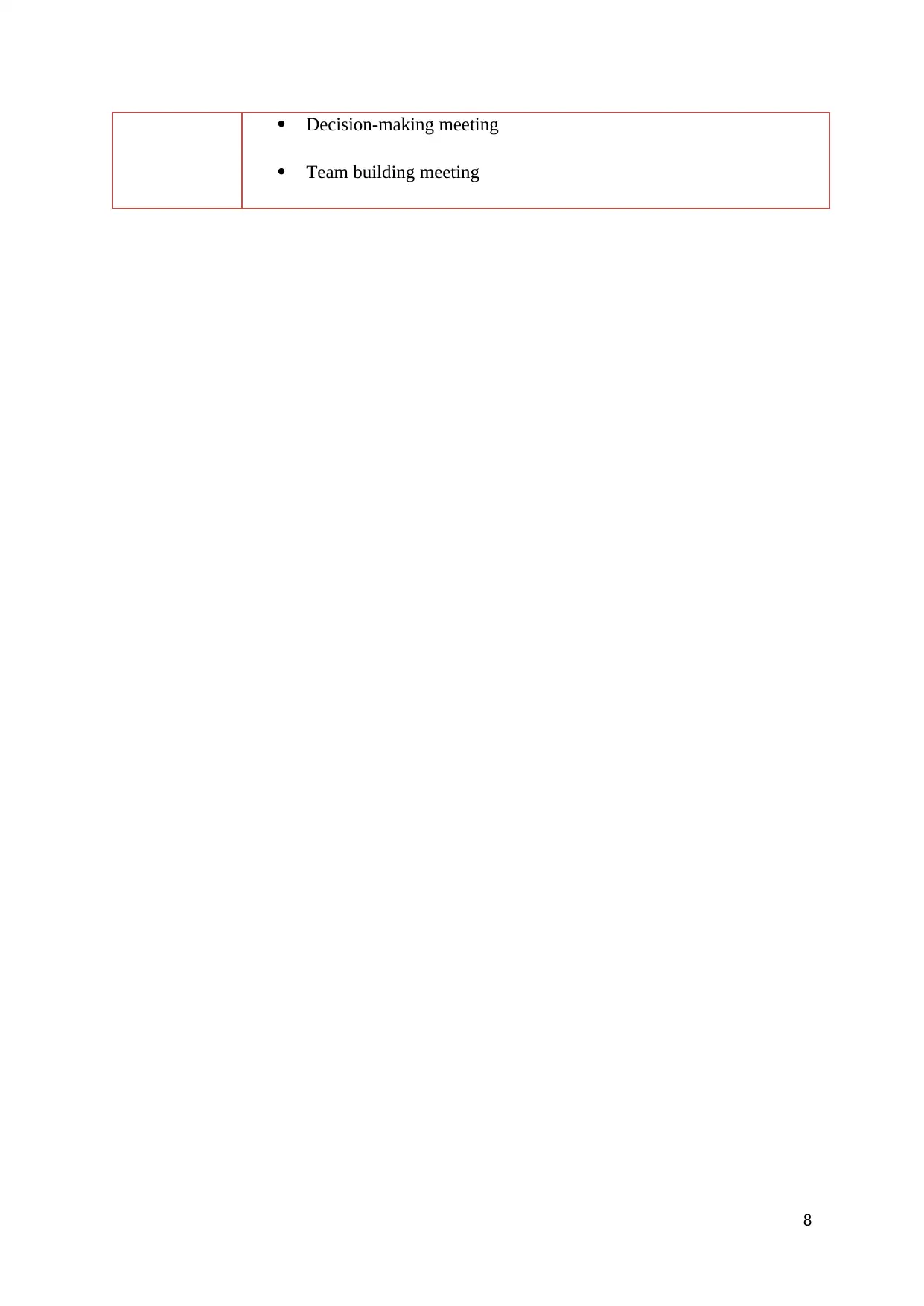
Decision-making meeting
Team building meeting
8
Team building meeting
8
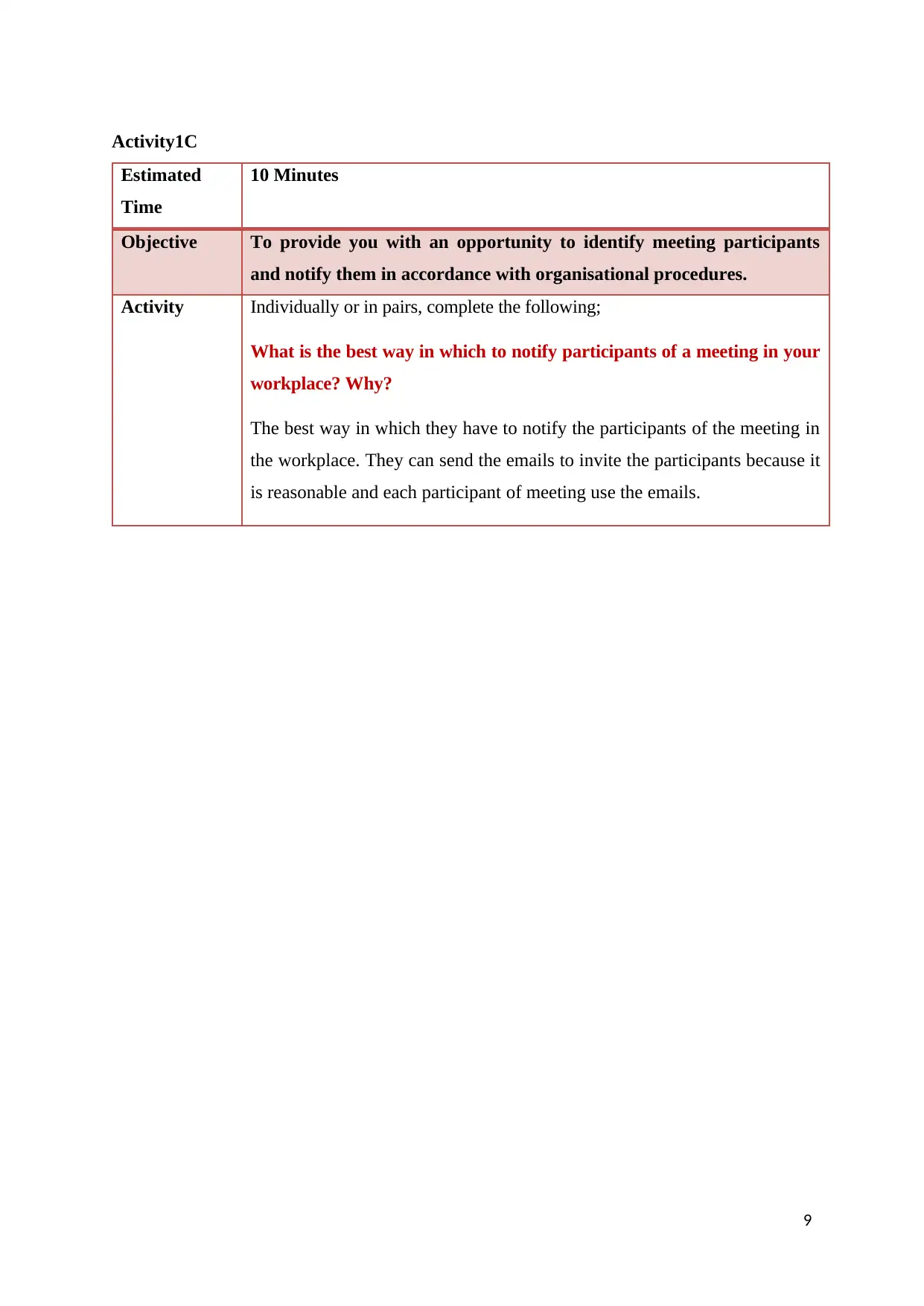
Activity1C
Estimated
Time
10 Minutes
Objective To provide you with an opportunity to identify meeting participants
and notify them in accordance with organisational procedures.
Activity Individually or in pairs, complete the following;
What is the best way in which to notify participants of a meeting in your
workplace? Why?
The best way in which they have to notify the participants of the meeting in
the workplace. They can send the emails to invite the participants because it
is reasonable and each participant of meeting use the emails.
9
Estimated
Time
10 Minutes
Objective To provide you with an opportunity to identify meeting participants
and notify them in accordance with organisational procedures.
Activity Individually or in pairs, complete the following;
What is the best way in which to notify participants of a meeting in your
workplace? Why?
The best way in which they have to notify the participants of the meeting in
the workplace. They can send the emails to invite the participants because it
is reasonable and each participant of meeting use the emails.
9
⊘ This is a preview!⊘
Do you want full access?
Subscribe today to unlock all pages.

Trusted by 1+ million students worldwide
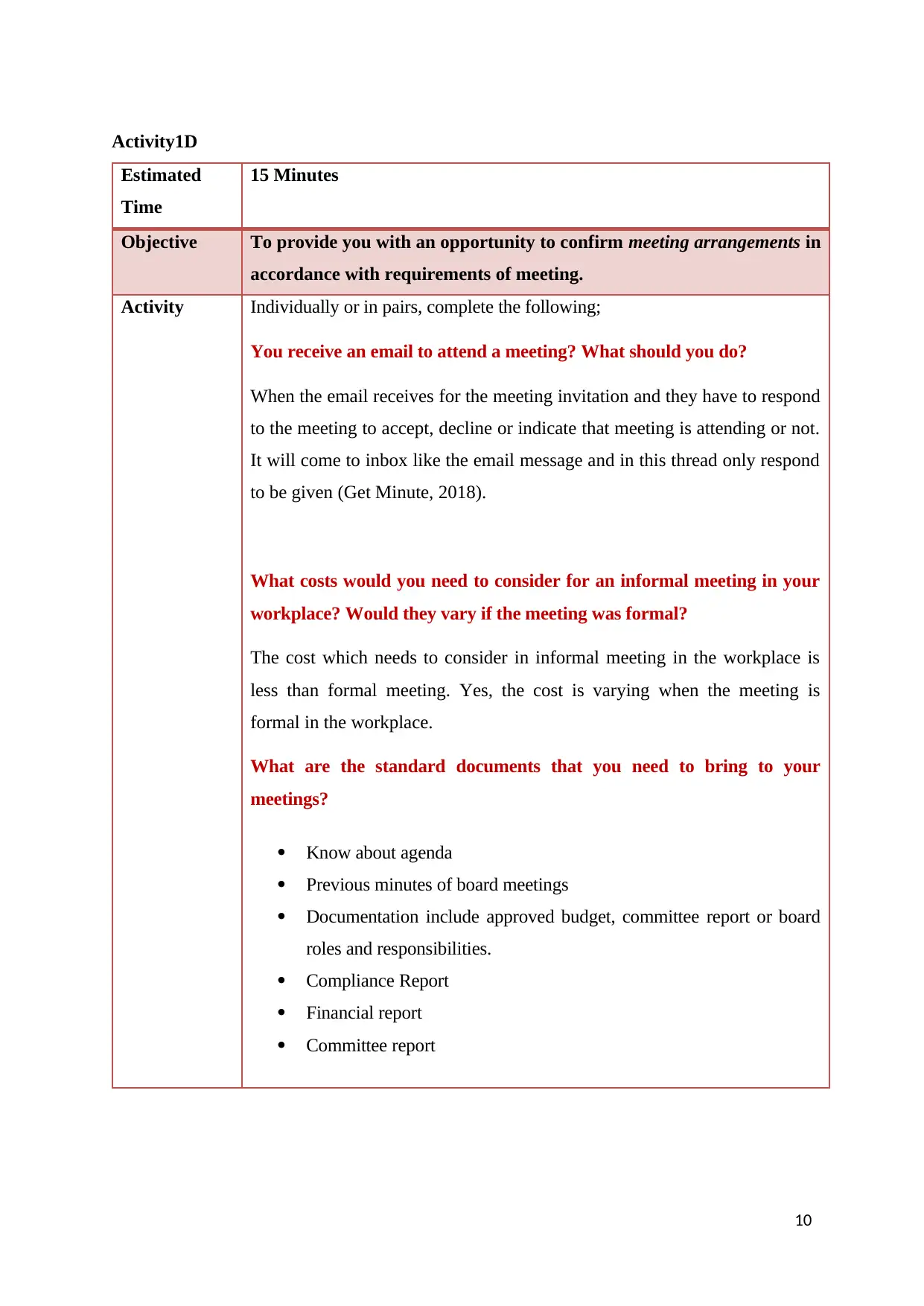
Activity1D
Estimated
Time
15 Minutes
Objective To provide you with an opportunity to confirm meeting arrangements in
accordance with requirements of meeting.
Activity Individually or in pairs, complete the following;
You receive an email to attend a meeting? What should you do?
When the email receives for the meeting invitation and they have to respond
to the meeting to accept, decline or indicate that meeting is attending or not.
It will come to inbox like the email message and in this thread only respond
to be given (Get Minute, 2018).
What costs would you need to consider for an informal meeting in your
workplace? Would they vary if the meeting was formal?
The cost which needs to consider in informal meeting in the workplace is
less than formal meeting. Yes, the cost is varying when the meeting is
formal in the workplace.
What are the standard documents that you need to bring to your
meetings?
Know about agenda
Previous minutes of board meetings
Documentation include approved budget, committee report or board
roles and responsibilities.
Compliance Report
Financial report
Committee report
10
Estimated
Time
15 Minutes
Objective To provide you with an opportunity to confirm meeting arrangements in
accordance with requirements of meeting.
Activity Individually or in pairs, complete the following;
You receive an email to attend a meeting? What should you do?
When the email receives for the meeting invitation and they have to respond
to the meeting to accept, decline or indicate that meeting is attending or not.
It will come to inbox like the email message and in this thread only respond
to be given (Get Minute, 2018).
What costs would you need to consider for an informal meeting in your
workplace? Would they vary if the meeting was formal?
The cost which needs to consider in informal meeting in the workplace is
less than formal meeting. Yes, the cost is varying when the meeting is
formal in the workplace.
What are the standard documents that you need to bring to your
meetings?
Know about agenda
Previous minutes of board meetings
Documentation include approved budget, committee report or board
roles and responsibilities.
Compliance Report
Financial report
Committee report
10
Paraphrase This Document
Need a fresh take? Get an instant paraphrase of this document with our AI Paraphraser
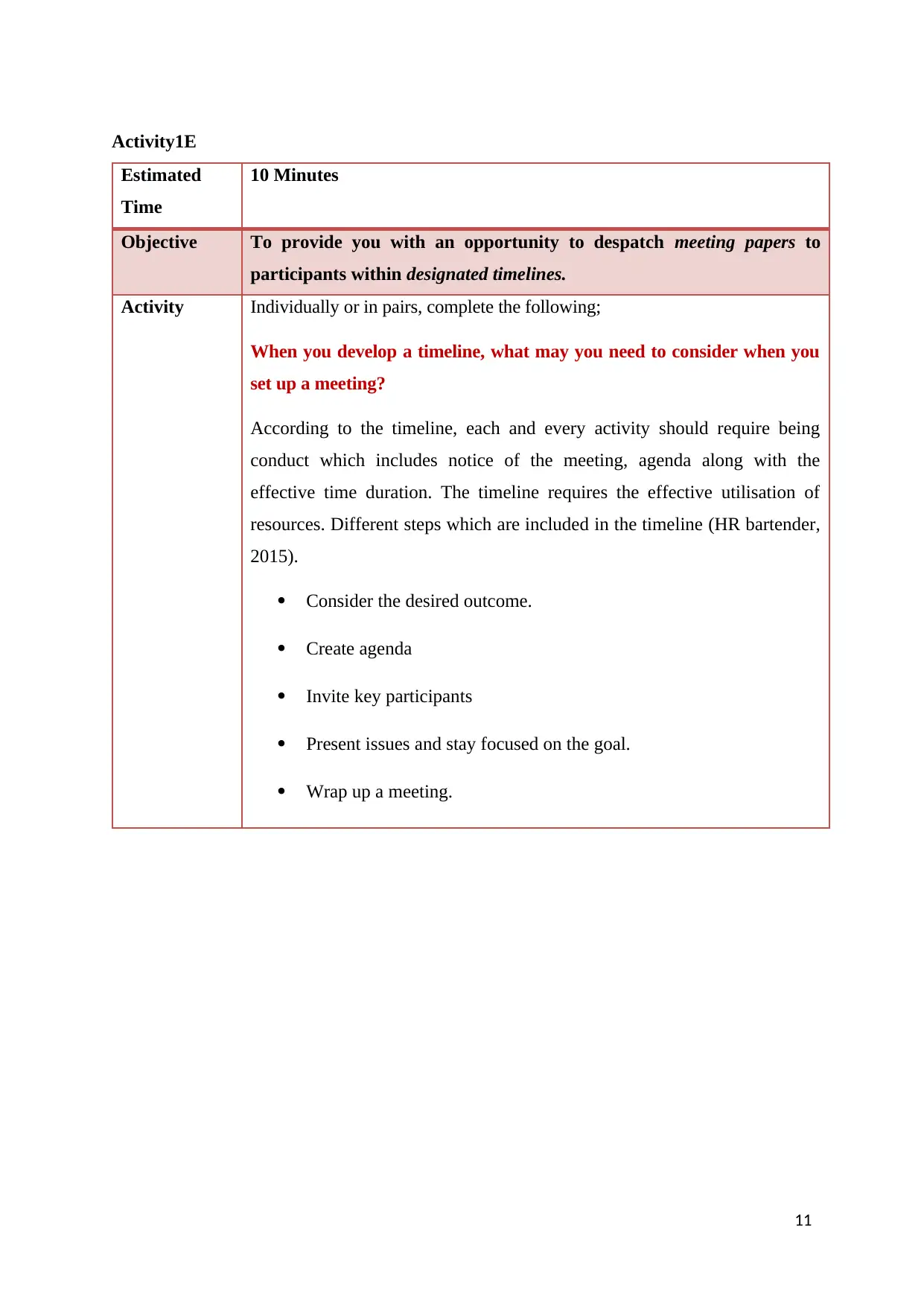
Activity1E
Estimated
Time
10 Minutes
Objective To provide you with an opportunity to despatch meeting papers to
participants within designated timelines.
Activity Individually or in pairs, complete the following;
When you develop a timeline, what may you need to consider when you
set up a meeting?
According to the timeline, each and every activity should require being
conduct which includes notice of the meeting, agenda along with the
effective time duration. The timeline requires the effective utilisation of
resources. Different steps which are included in the timeline (HR bartender,
2015).
Consider the desired outcome.
Create agenda
Invite key participants
Present issues and stay focused on the goal.
Wrap up a meeting.
11
Estimated
Time
10 Minutes
Objective To provide you with an opportunity to despatch meeting papers to
participants within designated timelines.
Activity Individually or in pairs, complete the following;
When you develop a timeline, what may you need to consider when you
set up a meeting?
According to the timeline, each and every activity should require being
conduct which includes notice of the meeting, agenda along with the
effective time duration. The timeline requires the effective utilisation of
resources. Different steps which are included in the timeline (HR bartender,
2015).
Consider the desired outcome.
Create agenda
Invite key participants
Present issues and stay focused on the goal.
Wrap up a meeting.
11
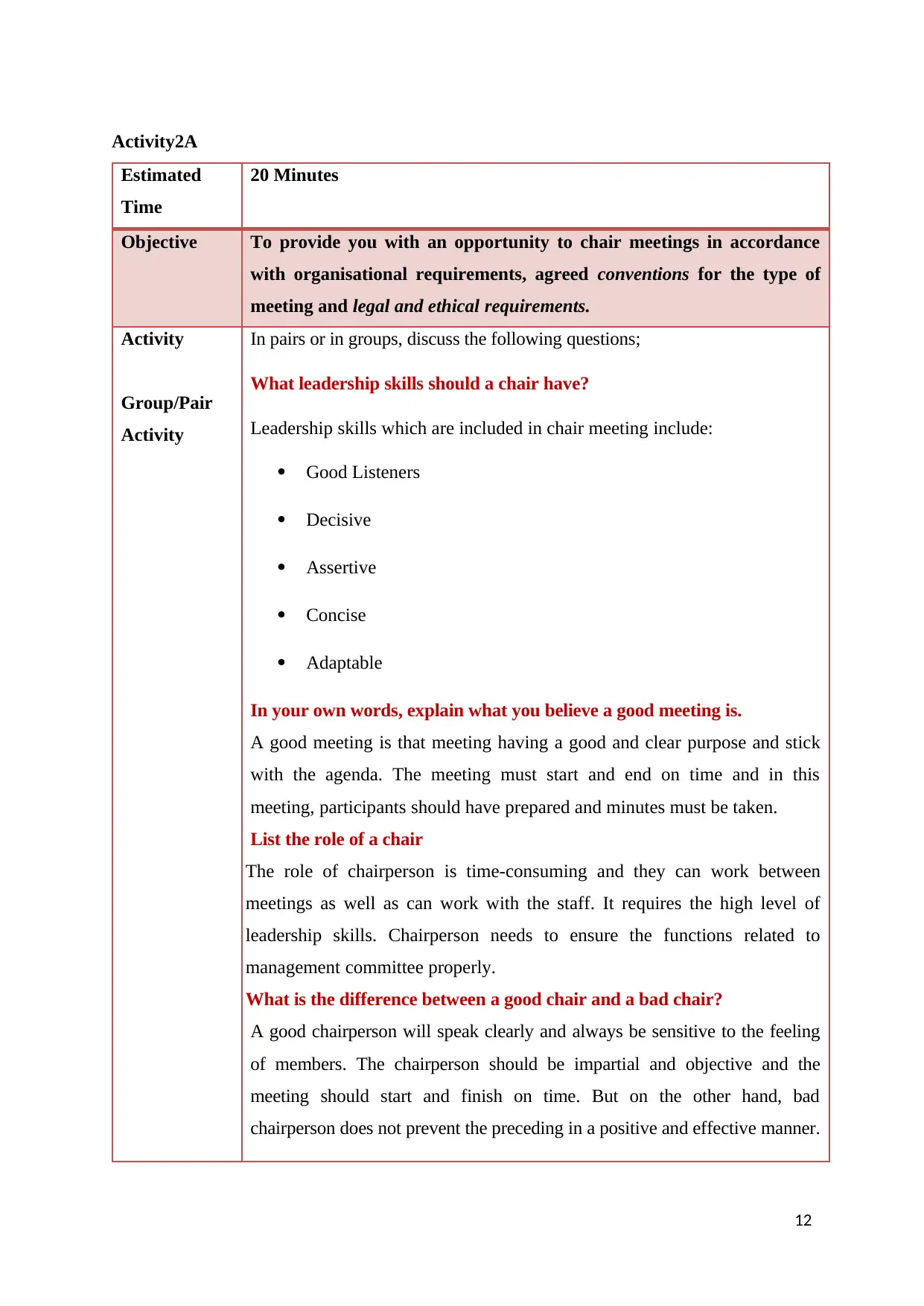
Activity2A
Estimated
Time
20 Minutes
Objective To provide you with an opportunity to chair meetings in accordance
with organisational requirements, agreed conventions for the type of
meeting and legal and ethical requirements.
Activity
Group/Pair
Activity
In pairs or in groups, discuss the following questions;
What leadership skills should a chair have?
Leadership skills which are included in chair meeting include:
Good Listeners
Decisive
Assertive
Concise
Adaptable
In your own words, explain what you believe a good meeting is.
A good meeting is that meeting having a good and clear purpose and stick
with the agenda. The meeting must start and end on time and in this
meeting, participants should have prepared and minutes must be taken.
List the role of a chair
The role of chairperson is time-consuming and they can work between
meetings as well as can work with the staff. It requires the high level of
leadership skills. Chairperson needs to ensure the functions related to
management committee properly.
What is the difference between a good chair and a bad chair?
A good chairperson will speak clearly and always be sensitive to the feeling
of members. The chairperson should be impartial and objective and the
meeting should start and finish on time. But on the other hand, bad
chairperson does not prevent the preceding in a positive and effective manner.
12
Estimated
Time
20 Minutes
Objective To provide you with an opportunity to chair meetings in accordance
with organisational requirements, agreed conventions for the type of
meeting and legal and ethical requirements.
Activity
Group/Pair
Activity
In pairs or in groups, discuss the following questions;
What leadership skills should a chair have?
Leadership skills which are included in chair meeting include:
Good Listeners
Decisive
Assertive
Concise
Adaptable
In your own words, explain what you believe a good meeting is.
A good meeting is that meeting having a good and clear purpose and stick
with the agenda. The meeting must start and end on time and in this
meeting, participants should have prepared and minutes must be taken.
List the role of a chair
The role of chairperson is time-consuming and they can work between
meetings as well as can work with the staff. It requires the high level of
leadership skills. Chairperson needs to ensure the functions related to
management committee properly.
What is the difference between a good chair and a bad chair?
A good chairperson will speak clearly and always be sensitive to the feeling
of members. The chairperson should be impartial and objective and the
meeting should start and finish on time. But on the other hand, bad
chairperson does not prevent the preceding in a positive and effective manner.
12
⊘ This is a preview!⊘
Do you want full access?
Subscribe today to unlock all pages.

Trusted by 1+ million students worldwide
1 out of 32
Related Documents
Your All-in-One AI-Powered Toolkit for Academic Success.
+13062052269
info@desklib.com
Available 24*7 on WhatsApp / Email
![[object Object]](/_next/static/media/star-bottom.7253800d.svg)
Unlock your academic potential
Copyright © 2020–2025 A2Z Services. All Rights Reserved. Developed and managed by ZUCOL.





